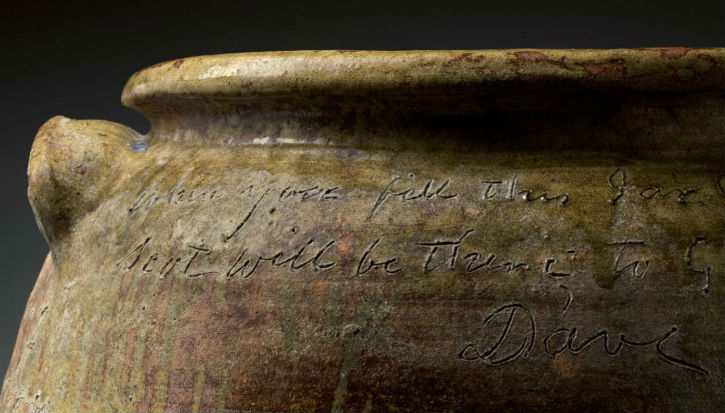
NEW YORK – The Metropolitan Museum of Art has purchased a rare stoneware storage jar by the enslaved African American potter and poet David Drake (circa 1801–1870s), it was announced Tuesday.
Made at the Stony Bluff Manufactory pottery site in Old Edgefield District, South Carolina, in 1858, the alkaline-glazed vessel is signed, dated and inscribed by Drake. There are currently approximately 40 known “poem vessels” signed or attributed to him.
“This acquisition celebrates the importance of David Drake and his creation of extraordinary, impressive, poetic objects. This vessel is truly transformative for our collection, as it will enable us to present a more nuanced and complex narrative not only of the Edgefield stoneware industry and the contributions of the enslaved potters, but of slavery in the American South,” said Max Hollein, director of the Met.
“David Drake was the only literate enslaved African American potter with a known body of work in this country. This remarkable jar, which bears a date, signature and an original four-line verse by Drake, was made a few years before the Civil War, during a time when it was illegal for enslaved African Americans to read or write. Signing and inscribing the jug was both a bold act of creativity and a declaration of authorship on Drake’s part,” noted Adrienne Spinozzi, assistant research curator of Decorative Arts in the American Wing.
Vast quantities of utilitarian vessels were made in Edgefield, South Carolina, the center of the 19th-century alkaline-glazed stoneware industry in the South. Drake wares stand apart due to their monumental size and textual embellishments. The Met’s example measures just over 22½ inches (57.5 cm) in height, with a capacity of about 25 gallons (94.6 liters). The large size and graceful form of the storage jug reveal the artist’s strength and dexterity as a potter and his exceptional facility with stoneware.
The inscription reads: “this jar is to Mr Segler who keeps the bar in orangeburg / for Mr Edwards a Gentle man – who formly kept / Mr thos bacons horses / April 21 1858”
[on opposite shoulder] “when you fill this Jar with pork or beef / Scot will be there; to get a peace, – / Dave” [and 25 slashes].

The verse – the longest known poem by this potter – serves as a portal into Drake’s 19th-century milieu. Notably, some of the individuals and places inscribed on the jar have been identified, and the vessel’s utilitarian purpose clearly stated – to fill with pork or beef – a reference to the likely intended use for food storage on a plantation.
This important example of Drake’s work comes from the private collection of Dr. Arthur and Esther Goldberg, longtime supporters of the American Wing. Funding for the purchase was provided by the Estate of Ronald Kane.
Selections from the Goldbergs’ noted American stoneware collection were exhibited at the Met in 1985. Examples of Drake’s poem vessels can also be found at the Philadelphia Museum of Art; Museum of Fine Arts, Boston; Smithsonian Institution; High Museum of Art; and the Charleston Museum, among others.
Currently on view in the American Wing’s “Civil War and Reconstruction Eras and Legacies” gallery (Gallery 762), the vessel will be featured in the Met’s upcoming exhibition on Edgefield stoneware, scheduled for early 2022.


